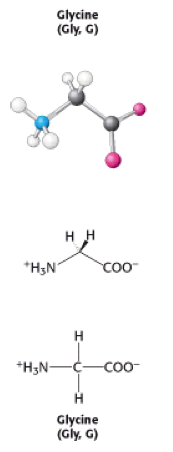Glycine: Difference between revisions
Added the paragraph about the history and etymology with references |
Cleaned up the references. |
||
| Line 1: | Line 1: | ||
Glycine is one of the 20 [[Amino acids|amino acids]]. | [[Image:Glycine.png|right|Glycine.png]] Glycine is one of the 20 [[Amino acids|amino acids]]. It's three letter code is Gly, and it's [[Single letter amino acid codes|single letter code]] is G. It is the simplest [[Amino acids|amino acid]], with a [[Hydrogen|hydrogen]] atom as a side chain - this means glycine is the only [[Amino acids|amino acid]] which does not have a [[Chiral carbon|chiral]] [[Carbon|carbon]] [[Atom|atom]]<ref name="Glycine">Priv.-Doz. B. Kirste. (01-23-1998). Glycine. Available: http://www.chemie.fu-berlin.de/chemistry/bio/aminoacid/glycin_en.html. Last accessed 23-11-2010.</ref>, so it does not form [[Stereoisomer|stereoisomers]] therefore will not have L or D configurations. | ||
Glycine has a function outside of the [[Cell|cell]]. It plays a vital role in the [[Central nervous system|central nervous system]] as is acts as a [[Neurotransmitter|neurotransmitter]] | Glycine has a function outside of the [[Cell|cell]]. It plays a vital role in the [[Central nervous system|central nervous system]] as is acts as a [[Neurotransmitter|neurotransmitter]] in chemical synapses<ref>Molecular biology of the cell,4th edition, 2002, Bruce Alberts, Alexander Johnson , Julian Lewis, Martin Raff , Keith Roberts and Peter Walter. Page 764</ref>. | ||
Glycine has two [[Hydrogen|hydrogens]] | Glycine has two [[Hydrogen|hydrogens]] attached to the [[Alpha carbon|alpha carbon]] and is found in flexible areas of proteins due to its short side chain<ref>http://www.acnp.org/g4/gn401000008/default.htm</ref><ref>Berg, J. M., Tymoczko, J. L., and Stryer, L. (2002). Biochemistry (5th ed.). New York: W.H. Freeman</ref>.<br> | ||
=== History and etymology === | === History and etymology === | ||
Glycine was discovered in 1820 by Henri Braconnot when he hydrolyzed gelatin by boiling it with sulfuric acid | Glycine was discovered in 1820 by Henri Braconnot when he hydrolyzed gelatin by boiling it with sulfuric acid <ref>R.H.A. Plimmer (1912) [1908]. R.H.A. Plimmer; F.G. Hopkins, eds. The chemical composition of the proteins. Monographs on biochemistry. Part I. Analysis (2nd ed.).</ref>. He originally called it "sugar of gelatin"<ref>MacKenzie, Colin (1822). One Thousand Experiments in Chemistry: With Illustrations of Natural Phenomena; and Practical Observations on the Manufacturing and Chemical Processes at Present Pursued in the Successful Cultivation of the Useful Arts . Sir R. Phillips and Company.</ref>, but a student of Liebig showed that it contained Nitrogen, and Berzelius renamed it "glycine"<ref>Nye, Mary Jo (1999). Before Big Science: The Pursuit of Modern Chemistry and Physics, 1800-1940. Harvard University Press. ISBN 9780674063822.</ref>. The name comes from the Greek word γλυκύς "sweet tasting"<ref>"glycine". Oxford Dictionaries. Retrieved 2015-12-06.</ref> (which is also related to the prefixes glyco- and gluco-, as in glycoprotein and glucose). Another early name for glycine was "glycocoll"<ref>Ihde, Aaron J. (1970). The Development of Modern Chemistry. Courier Corporation. ISBN 9780486642352.</ref>. | ||
=== References === | === References === | ||
<references / | <references /> | ||
Revision as of 21:43, 5 December 2017

Glycine is one of the 20 amino acids. It's three letter code is Gly, and it's single letter code is G. It is the simplest amino acid, with a hydrogen atom as a side chain - this means glycine is the only amino acid which does not have a chiral carbon atom[1], so it does not form stereoisomers therefore will not have L or D configurations.
Glycine has a function outside of the cell. It plays a vital role in the central nervous system as is acts as a neurotransmitter in chemical synapses[2].
Glycine has two hydrogens attached to the alpha carbon and is found in flexible areas of proteins due to its short side chain[3][4].
History and etymology
Glycine was discovered in 1820 by Henri Braconnot when he hydrolyzed gelatin by boiling it with sulfuric acid [5]. He originally called it "sugar of gelatin"[6], but a student of Liebig showed that it contained Nitrogen, and Berzelius renamed it "glycine"[7]. The name comes from the Greek word γλυκύς "sweet tasting"[8] (which is also related to the prefixes glyco- and gluco-, as in glycoprotein and glucose). Another early name for glycine was "glycocoll"[9].
References
- ↑ Priv.-Doz. B. Kirste. (01-23-1998). Glycine. Available: http://www.chemie.fu-berlin.de/chemistry/bio/aminoacid/glycin_en.html. Last accessed 23-11-2010.
- ↑ Molecular biology of the cell,4th edition, 2002, Bruce Alberts, Alexander Johnson , Julian Lewis, Martin Raff , Keith Roberts and Peter Walter. Page 764
- ↑ http://www.acnp.org/g4/gn401000008/default.htm
- ↑ Berg, J. M., Tymoczko, J. L., and Stryer, L. (2002). Biochemistry (5th ed.). New York: W.H. Freeman
- ↑ R.H.A. Plimmer (1912) [1908]. R.H.A. Plimmer; F.G. Hopkins, eds. The chemical composition of the proteins. Monographs on biochemistry. Part I. Analysis (2nd ed.).
- ↑ MacKenzie, Colin (1822). One Thousand Experiments in Chemistry: With Illustrations of Natural Phenomena; and Practical Observations on the Manufacturing and Chemical Processes at Present Pursued in the Successful Cultivation of the Useful Arts . Sir R. Phillips and Company.
- ↑ Nye, Mary Jo (1999). Before Big Science: The Pursuit of Modern Chemistry and Physics, 1800-1940. Harvard University Press. ISBN 9780674063822.
- ↑ "glycine". Oxford Dictionaries. Retrieved 2015-12-06.
- ↑ Ihde, Aaron J. (1970). The Development of Modern Chemistry. Courier Corporation. ISBN 9780486642352.